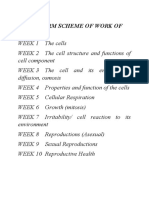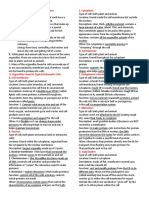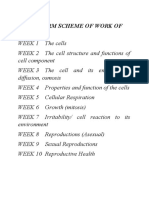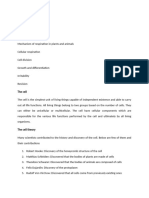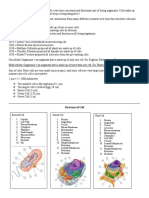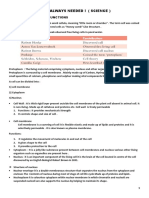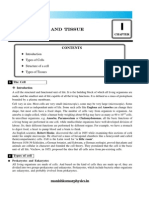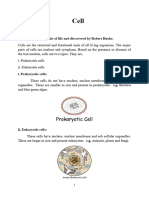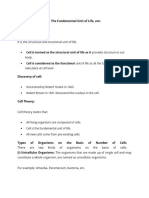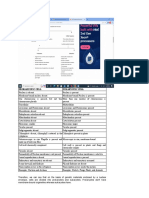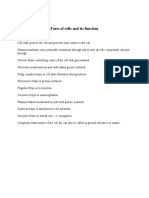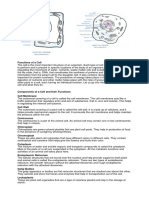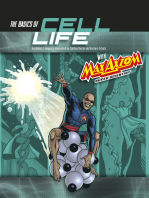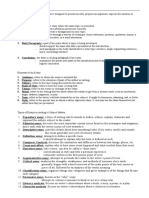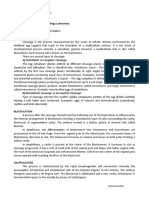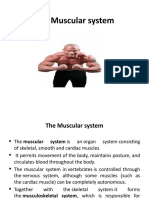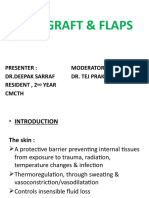0 ratings0% found this document useful (0 votes)
23 viewsCell Structure and Function Lecture
Uploaded by
Nins SarmientoCopyright
© © All Rights Reserved
Available Formats
Download as DOCX, PDF, TXT or read online on Scribd
0 ratings0% found this document useful (0 votes)
23 viewsCell Structure and Function Lecture
Uploaded by
Nins SarmientoCopyright
© © All Rights Reserved
Available Formats
Download as DOCX, PDF, TXT or read online on Scribd
You are on page 1/ 2
Cell Structure and Function
Robert Hooke Cell
● In 1665, he discovered tiny compartments in a The cell is the basic structural unit of life.
thin slice of cork using his compound
microscope. He called these compartments Type of Eukaryotic Cell
cells. 1. Animal Cell - An animal cell is a type of
eukaryotic cell that lacks a cell wall and has a
Cell Theory true, membrane-bound nucleus along with
● The classical cell theory was proposed by other cellular organelles.
Theodor Schwann in 1839. 2. Plant Cell - Plant cells are eukaryotic cells with a
1. All organisms are made of cells. true nucleus along with specialized structures
2. Cells are the basic units of life. called organelles that carry out certain specific
● These parts were based on a conclusion made functions.
by Schwann and Matthias Schleiden in 1838,
after comparing their observations of plant and Parts and Functions of a Typical Cell
animal cells. 1. Plasma/Cell membrane
3. Cells come from preexisting cells that have “security guard’
multiplied. controls the kind of substance that enters the
The third part, was described by Rudolf Virchow cell
in 1858, when he stated omnis cellula e cellula Without the plasma membrane, any substance
(all cells come from cells). can go in and out of the cell
4. DNA is passed between cells during cell 2. Nucleus
division. contains the DNA
5. Cells of all organisms within a similar “brain of the cell”
species are mostly the same, both It controls all the activities occurring inside the
structurally and chemically. cell
6. Energy flow occurs within cells. 3. Nucleolus
where ribosomes are produced
Type of Cells 4. Nuclear Membrane
Separates the nuclear contents from the
1. Prokaryotic Cell contents of the cytoplasm.
pro = before; karyon = nucleus 5. Nucleoplasm
● DNA (NO NUCLUES) It is the gel-like material that fills the nucleus.
● CYTOPLASM 6. Chromosome
● RIBOSOME Carriers of genes responsible in transmitting
● CELL MEMBRANE hereditary characteristics.
● NO NUCLEUS 7. Cytoplasm
● NO MEMBRANE-BOUND A jelly-like substance
ORGANELLES Contains the organelles of the cell
ORGANELLES
2. Eukaryotic Cell are specialized parts of the cell that perform
eu = true; karyon = nucleus specific functions
● DNA (IN NUCLEUS) 8. Mitochondrion
● CYTOPLASM powerhouse of the cell
● RIBOSOME Releases the energy needed for cell activities
● CELL MEMBRANE supply energy by undergoing cellular respiration
● NUCLEUS produces adenosine triphosphate (ATP)
● MEMBRANE-BOUND 9. Ribosomes
ORGANELLES protein factory of the cell
carry out the instructions coming from the
nucleus to synthesize proteins
10. Endoplasmic Reticulum
Two Types of ER:
a) Smooth Endoplasmic Reticulum
No ribosomes
Involved in the synthesis of lipids and
carbohydrates that are used to build the
cell membrane
b) Rough Endoplasmic Reticulum
Presence of ribosomes
Involved in the production of various
proteins in the cell, antibodies, insulin, as
well as transportation of proteins into the
smooth ER.
11. Golgi Body
“Mailman of the cell”
Responsible for transporting, modifying, and
packaging proteins and lipids into vesicles for
delivery to targeted destinations
12. Vacuoles
“storage rooms of the cells”
membrane bound structure which main
function is for storage of food, water, and even
waste
13. Lysosomes
“suicide bags of the cell”
act as the waste disposal system of the cell by
digesting or breaking down the thrash or
unneeded materials in the cytoplasm
14. Centrioles
cylindrical structure which plays an important
role in cell division
can only be found on animal cells
15. Chloroplast
contain the pigment chlorophyll that captures
energy from sunlight for photosynthesis
the site of photosynthesis
o Chlorophyll provides green color to
leaves and helps in the process of
photosynthesis.
16. Cell Wall
outer covering positioned next to the cell
membrane in most plant cells, fungi, bacteria,
algae, and some archaea.
made of cellulose that protect, support, and
give plants their shape.
You might also like
- Cell Structure: Structural Functional Unit: Unit100% (1)Cell Structure: Structural Functional Unit: Unit13 pages
- Key Notes For Chapter-The Fundamental Unit of Life, Are: CellNo ratings yetKey Notes For Chapter-The Fundamental Unit of Life, Are: Cell14 pages
- GB1 2 Cell Structures Functions to Cell ModificationsNo ratings yetGB1 2 Cell Structures Functions to Cell Modifications60 pages
- The Basics of Cell Life with Max Axiom, Super Scientist: 4D An Augmented Reading Science ExperienceFrom EverandThe Basics of Cell Life with Max Axiom, Super Scientist: 4D An Augmented Reading Science ExperienceNo ratings yet
- The Animal Cell and Division Biology for Kids | Children's Biology BooksFrom EverandThe Animal Cell and Division Biology for Kids | Children's Biology BooksNo ratings yet
- Aug 5-9 NMP HGP LP Sarmiento, Nina ThereseNo ratings yetAug 5-9 NMP HGP LP Sarmiento, Nina Therese7 pages
- Learning Plan Grade 7 Third Quarter MATATAG_3No ratings yetLearning Plan Grade 7 Third Quarter MATATAG_310 pages
- Notes in Uses of Mirrors and Lenses in Optical Devices100% (1)Notes in Uses of Mirrors and Lenses in Optical Devices2 pages
- Histology of The Gastrointestinal TractNo ratings yetHistology of The Gastrointestinal Tract10 pages
- Leukemia Cancer of The Blood: Professor Rolland Merch M. Arriza Mindanao State University - General Santos CityNo ratings yetLeukemia Cancer of The Blood: Professor Rolland Merch M. Arriza Mindanao State University - General Santos City31 pages
- True/False: Indicate Whether The Statement Is True or FalseNo ratings yetTrue/False: Indicate Whether The Statement Is True or False5 pages
- Insect Physiology: Developmental SystemsNo ratings yetInsect Physiology: Developmental Systems47 pages
- Life Sciences Gr.10 Lesson 50 Support and transport system in plants. Translocation of manufacturNo ratings yetLife Sciences Gr.10 Lesson 50 Support and transport system in plants. Translocation of manufactur14 pages
